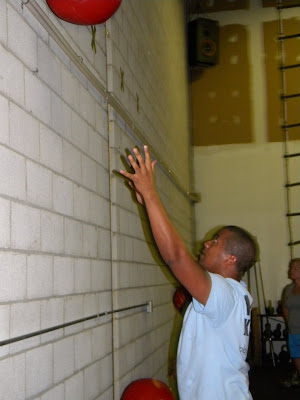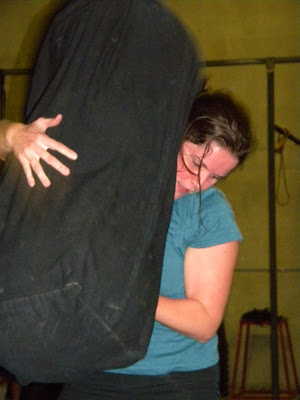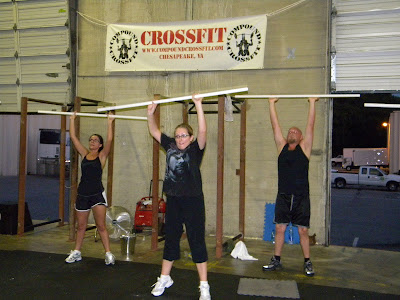When first starting CrossFit and even Boot Camp, many ladies are concerned about "bulking up" as a result of the type of workouts they perform. If you walk around the Compound (or any CrossFit gym), you'll notice that most of the top ladies in these gyms are muscular, but not bulky or lacking femininity.
Check out the article below...
Top 10 Reasons Heavy Weights Don’t Bulk Up the Female AthleteBy Tim Kontos, David Adamson, and Sarah Walls
For www.EliteFTS.com
--------------------------------------------------------------------------------
David Adamson and I were driving to the IPA Nationals this past weekend talking training (yeah we’re pretty passionate about what we do) when the subject of training women with heavy weights came up. I’m in my ninth year at Virginia Commonwealth University (VCU) as the head strength and conditioning coach, and David has been in strength and conditioning for three years. This is a subject we deal with every year regardless of how much training information is available to the public.
The best way to get information is to go to the source. So we asked Sarah Walls, another strength and conditioning coach at VCU. Sarah is also a writer for Muscle and Fitness Hers, a former figure competitor, and a women’s tri-fitness competitor—not to mention a strong female athlete who isn’t bulked up. Therefore, she has a great perspective on the subject.
We, being a good team, put our heads together to find a way to combat this never-ending dilemma. Our way of doing that is through education. And, only one answer to a question is never enough. If you know your job well, then you know that there is more than one way to skin a cat. So we came up with the following list:
1. Women do not have nearly as much testosterone as men. In fact, according to Bill Kreamer in Essentials of Strength Training and Conditioning, women have about 15 to 20 times less testosterone than men. Testosterone is the reason men are men and women are women. After men hit puberty, they grow facial hair, their voice deepens, and they develop muscle mass. Because men have more testosterone, they are much more equipped to gain muscle. Because women do not have very much testosterone in their bodies, they will never be able to get as big as men.
2. The perception that women will bulk up when they begin a strength training program comes from the chemically-altered women on the covers of bodybuilding magazines. These “grocery stand models” are most likely pumped full of some extra juice. This is why they look like men. If you take the missing link that separates men from women and add it back in, what do you have? A man!
3. For women, toning is what happens when the muscle is developed through training. This is essentially bodybuilding without testosterone. Since the testosterone is not present in sufficient amounts, the muscle will develop, but it won’t gain a large amount of mass. The “toned” appearance comes from removing the fat that is covering a well-developed muscle.
4. Muscle bulk comes from a high volume of work. The repetition range that most women would prefer to do (8–20 reps) promotes hypertrophy (muscle growth). For example, a bodybuilding program will have three exercises per body part. For the chest, they will do flat bench for three sets of 12, incline for three sets of 12, and decline bench for three sets of 12. This adds up to 108 total repetitions. A program geared towards strength will have one exercise for the chest—flat bench for six sets of three with progressively heavier weight. This equals 18 total repetitions. High volume (108 reps) causes considerable muscle damage, which in turn, results in hypertrophy. The considerably lower volume (18 reps) will build more strength and cause minimal bulking.
5. Heavy weights will promote strength not size. This has been proven time and time again. When lifting weights over 85 percent, the primary stress imposed upon the body is placed on the nervous system, not on the muscles. Therefore, strength will improve by a neurological effect while not increasing the size of the muscles.
And, according to Zatsiorsky and Kreamer in Science and Practice of Strength Training, women need to train with heavy weights not only to strengthen the muscles but also to cause positive adaptations in the bones and connective tissues.
6. Bulking up is not an overnight process. Many women think they will start lifting weights, wake up one morning, and say “Holy sh__! I’m huge!” This doesn’t happen. The men that you see who have more muscle than the average person have worked hard for a long time (years) to get that way. If you bulk up overnight, contact us because we want to do what you’re doing.
7
. What the personal trainer is prescribing is not working. Many female athletes come into a new program and say they want to do body weight step-ups, body weight lunges, and leg extensions because it’s what their personal trainer back home had them do. However, many of these girls need to look in a mirror and have a reality check because their trainer’s so-called magical toning exercises are not working. Trainers will hand out easy workouts and tell people they work because they know that if they make the program too hard the client will complain. And, if the client is complaining, there’s a good chance the trainer might lose that client (a client to a trainer equals money).
8. Bulking up is calorie dependant. This means if you eat more than you are burning, you will gain weight. If you eat less than you are burning, you will lose weight. Unfortunately, most female athletes perceive any weight gain as “bulking up” and do not give attention to the fact that they are simply getting fatter. As Todd Hamer, a strength and conditioning coach at George Mason University said, “Squats don’t bulk you up. It’s the ten beers a night that bulk you up.” This cannot be emphasized enough.
If you’re a female athlete and training with heavy weights (or not), you need to watch what you eat. Let’s be real—the main concern that female athletes have when coming to their coach about gaining weight is not their performance but aesthetics. If you choose to ignore this fact as a coach, you will lose your athletes!
9. The freshman 15 is not caused by strength training. It is physiologically impossible to gain 15 lbs of muscle in only a few weeks unless you are on performance enhancing drugs. Yes the freshman 15 can come on in only a few weeks. This becomes more complex when an athlete comes to a new school, starts a new training program, and also has a considerable change in her diet (i.e. only eating one or two times per day in addition to adding 6–8 beers per evening for 2–4 evenings per week). They gain fat weight, get slower, and then blame the strength program. Of course, strength training being the underlying cause is the only reasonable answer for weight gain. The fact that two meals per day has slowed the athlete’s metabolism down to almost zero and then the multiple beers added on top of that couldn’t have anything to do with weight gain...it must be the lifting.
10. Most of the so-called experts are only experts on how to sound like they know what they are talking about. The people who “educate” female athletes on training and nutrition have no idea what they’re talking about. Let’s face it—how many people do you know who claim to “know a thing or two about lifting and nutrition?” Now, how many people do you know who actually know what they’re talking about, have lived the life, dieted down to make a weight class requirement, or got on stage at single digit body fat? Invariably, these so-called experts are also the people who blame their gut on poor genetics.
These so-called experts are the reason you see so many women doing sets of 10 with a weight they could do 20 or 30 times. They are being told by the experts that this is what it takes to “tone” the muscles. Instead, they are only wasting their time doing an exercise with a weight that is making no contribution to the fitness levels or the development of the muscle.
In case you haven’t figured it out by this point in the article, what is currently being done in fitness clubs to help female athletes tone their bodies is not working. It’s not helping these women get toned, and it is definitely not helping improve athletic performance. Maybe it’s time for a change. Contrary to the ineffective light weights currently being used, heavy weights offer many benefits for women including improved body composition, stronger muscles, decreased injury rate, and stronger bones (which helps prevent osteoporosis). Let’s try lifting some heavy weights and controlling our diet and watch this logical, science-based solution make the difference we’ve been looking for.
Tim Kontos is in his ninth year as the strength and conditioning coach for Virginia Commonwealth University athletes. A certified strength and conditioning specialist with the National Strength and Conditioning Association, Kontos designs, implements, and supervises all strength, speed, and agility programs for all the VCU athletic programs.
David Adamson is in his second year as an assistant strength and conditioning coach for VCU. He is directly responsible for program design and implementation for men’s and women’s track and field, women’s cross country, and field hockey. Prior to coming to VCU, David worked at the University of Wisconsin-La Crosse, Arizona State University, and Winona State University. In 2003, he graduated from the University of Wisconsin-La Crosse, and in 2006, he received his masters in sport leadership from VCU.
Sarah Walls is in her first year with the Rams’ strength and conditioning staff as a graduate assistant working with men’s and women’s soccer, golf, and men’s cross-country. Graduating magna cum laude, she earned a bachelor’s of science degree from Virginia Tech in 2003. Since graduation, she has spent time working at George Mason University in Fairfax, Virginia in the strength department. While there, Sarah worked with women’s tennis, men’s tennis, men’s volleyball, and men’s soccer. At the same time, she also worked for LifeTime Fitness and helped manage and develop innovative training programs. In addition, she is a contributing writer for the magazine, Muscle and Fitness HERS.
Elite Fitness Systems strives to be a recognized leader in the strength training industry by providing the highest quality strength training products and services while providing the highest level of customer service in the industry. For the best training equipment, information, and accessories, visit us at www.EliteFTS.com.



























































